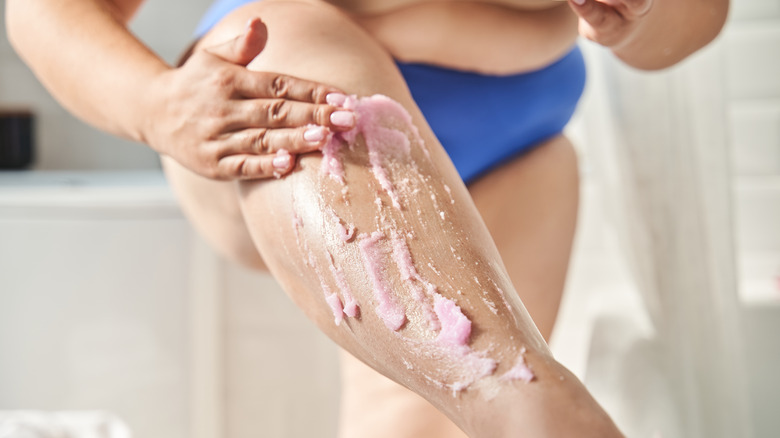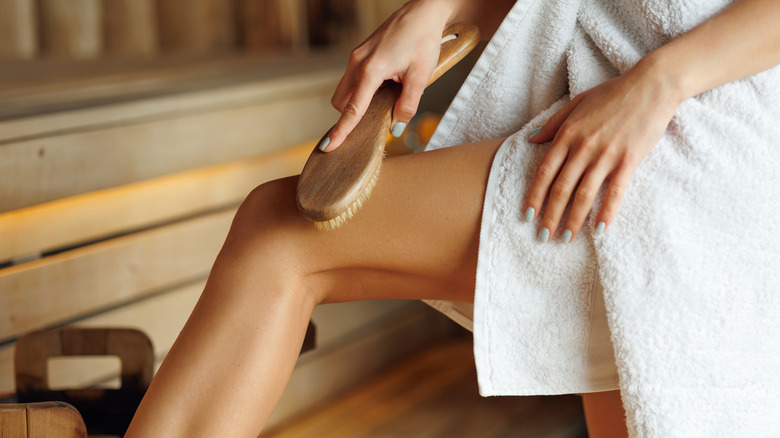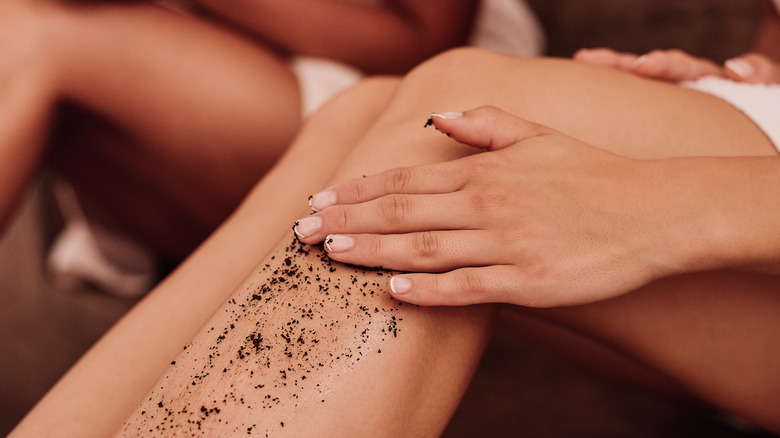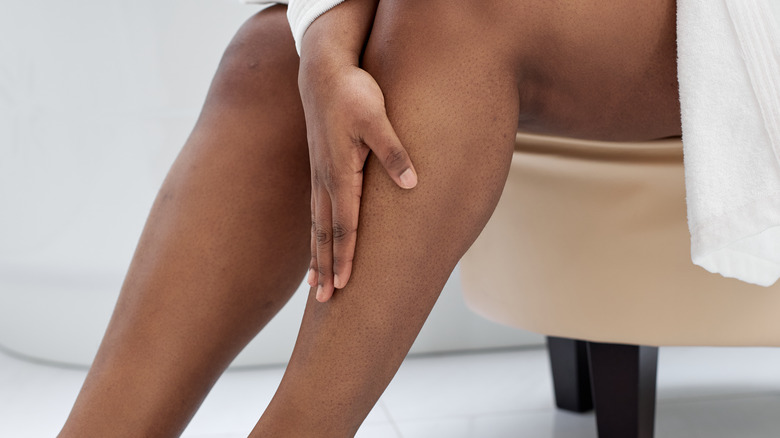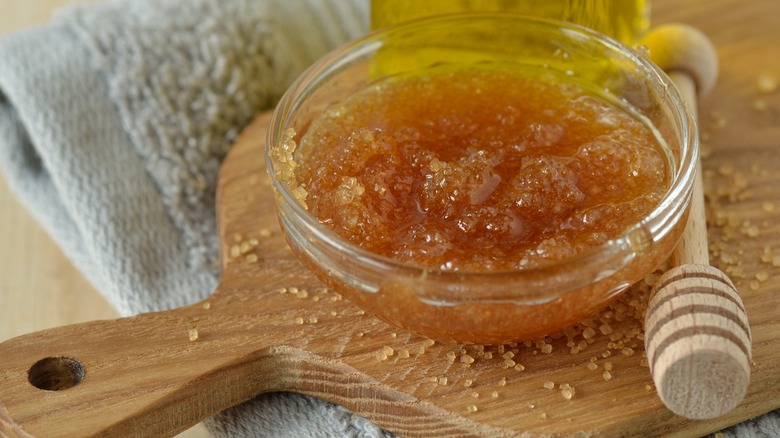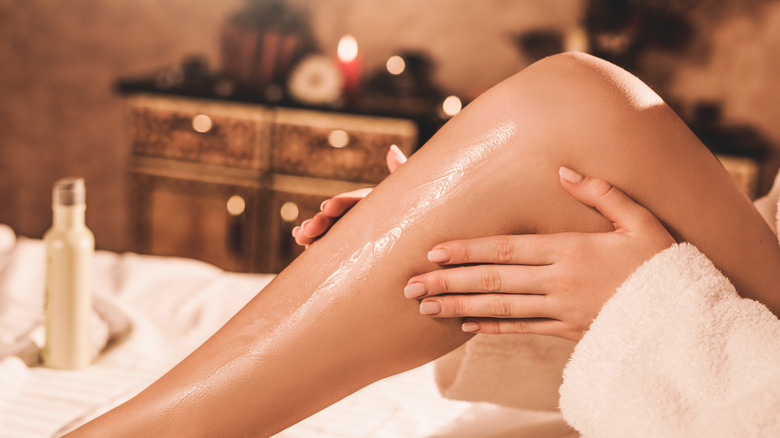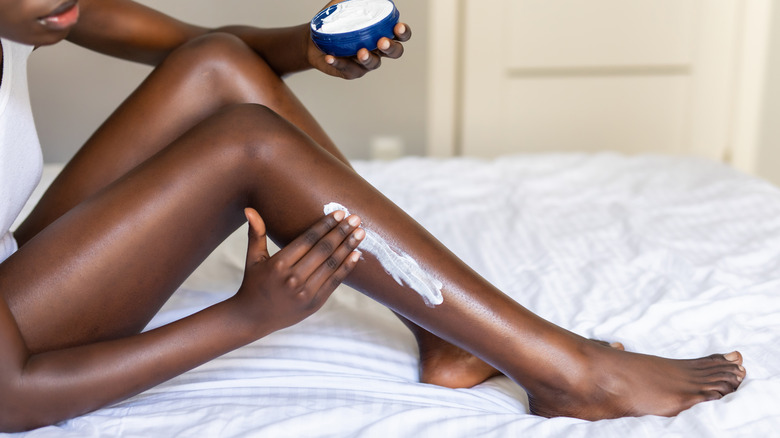Why You Should Be Exfoliating Your Legs — And How To Do It Properly
We may receive a commission on purchases made from links.
Exfoliating might already be a part of your facial skincare routine, but don't forget to care for other parts of the body — specifically your legs. While our skin sheds naturally each month, there can sometimes still be dead skin cells that build up and cause flaky, dry patches. Dermatologist Tina Alster, MD explained to Byrdie, "While dry skin may simply need moisture, flaky surface skin cells can be removed with gentle exfoliation to provide a smoother skin surface and improve circulation." Dr. Alster also explains that exfoliating is helpful if you shave your legs often, as it reduces ingrown hairs and gives you an easier shave.
Not only are you eliminating build-up and dead skin, but you're also getting silky smooth skin. Who doesn't love that? According to experts at Healthline, exfoliating can also increase collagen production over time, which helps the skin stay glowing and healthy. With so many different exfoliating products out there, it can be confusing to know where to start. It's important to know how to exfoliate properly and according to your own skin type, so you don't cause any irritation or damage.
Physical versus chemical exfoliating
The type of exfoliation you choose depends on your skin type. Physical exfoliation involves using a tool, like a dry brush, body scrub, washcloth, or loofah to remove dead skin. Physical exfoliants sometimes get a bad rep, but they're only harmful when used too much or on sensitive skin. With chemical exfoliation, you're using a product with AHA (alpha hydroxy acid) or BHA (beta hydroxy acid) that dissolves dead skin cells.
If you have sensitive skin, the American Academy of Dermatology recommends chemical exfoliation. Products with a BHA, like salicylic acid, tend to be a bit gentler on the skin compared to AHAs, such as glycolic acid. Physical exfoliation is more abrasive and can be too irritating on sensitive skin, which is why it's better suited for oily and thicker skin. As you establish an exfoliating routine, you can see which exfoliation method works best for you.
What you'll need for exfoliating
Once you determine which type of exfoliation is best for you, make sure you have the products you need. If you're taking the physical exfoliation route, you'll need a dry brush. Dermatologic surgeon Dendy Engelman, MD explained to Byrdie that dry brushing increases circulation and helps with lymphatic drainage, along with exfoliating the skin. If a brush feels too abrasive, you can also use a damp washcloth.
You'll also need a body polish, which is a grainy formula that contains an exfoliator like sugar, salt, or coffee grounds. You can purchase body polish, or you can make your own. Dr. Alster recommends brown sugar and olive oil. "Brown sugar is a source of glycolic acid that's helpful in loosening dead skin cells while olive oil contains natural antioxidants that may help to protect the skin from environmental damage," she tells Byrdie.
For the last steps, you'll need a body oil and moisturizer to restore your skin's moisture and allow it to recover after exfoliating.
Cleanse your skin first
According to experts at Medical News Today, it's best to cleanse the skin before exfoliating. Cleansing first can help remove dirt and unclog pores before you go in to exfoliate, and it gives you a clean surface to work with. You can choose to exfoliate while you're in the shower or right after you get out.
Rub the skin in circular motions
If you're going for physical exfoliation with a brush or cloth, gently rub your legs by using small, circular motions. Do this for about 30 seconds in each area. You may see some flakes of dead skin begin to fall off. Once you feel like you've done enough, rinse off some of that dead skin.
If you're using a chemical exfoliant, apply the product with your hands and gently rub it on the skin in circular motions. Follow the instructions on the products you use, as some need to be rinsed off, while others can be left on.
Use a body polish
After you've done your initial exfoliating, experts at Byrdie recommend a body polish that cleanses and exfoliates simultaneously, like Dove's Exfoliating Body Polish. Go in for round two of exfoliating with your body polish to remove any more dead skin that you may have missed in the first step. You can use your hand or your exfoliating tool, as long as it doesn't irritate the skin further. Then, rinse off the body polish with lukewarm water.
Dry off and apply body oil
Pat your legs dry with a freshly clean towel, and then apply your favorite body oil. The oil helps to "restore the skin's moisture and build back the barrier," dermatologic surgeon Dendy Engelman, MD told Byrdie. Let the oil fully absorb into the skin. We recommend using one with vitamin E, like Palmer's Cocoa Butter Moisturizing Body Oil.
Finish up with lotion
After you've let the body oil absorb, use your favorite body lotion to help the skin recover. Moisturizing is arguably the most important step when it comes to exfoliating, as it helps the skin retain moisture and recover since the skin has been stripped of oils and dead skin. Once the lotion is absorbed, you're all done!
How often should you exfoliate your legs?
We all know the saying, "Everything in moderation." This applies to exfoliating, too. It's not something you need to do every day, and it's generally not recommended if you have sensitive skin. When done too harshly and too often, it can do more harm than good, leaving your legs irritated and damaged. Exfoliating once or twice a week will suffice, and the frequency depends on your skin type.
Listen to your skin; if it's prone to sensitivity, exfoliating daily or more than once a week can further irritate the skin. Doing it too often is one of many exfoliating mistakes you don't want to make. For dry and sensitive skin, exfoliate once every other week with a gentle product. If your skin appears red, inflamed, or if it's tender to the touch, you may have gone a little too hard or you're exfoliating too frequently. You know your skin best, so exfoliate on an as-needed basis.
